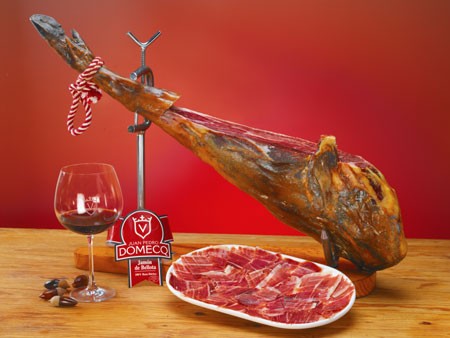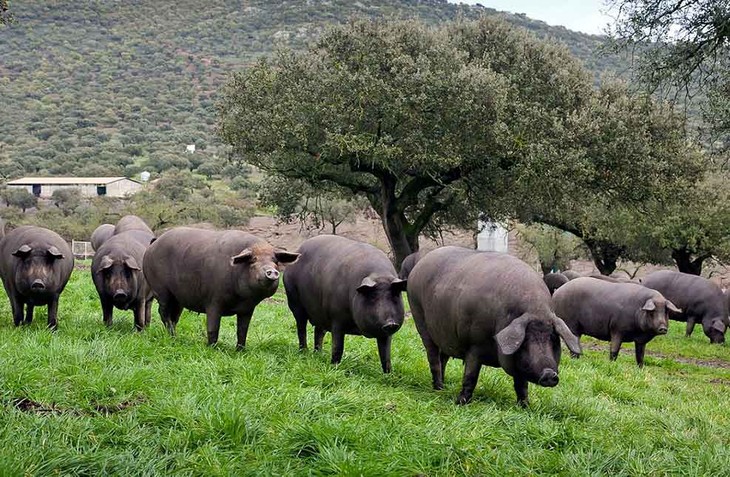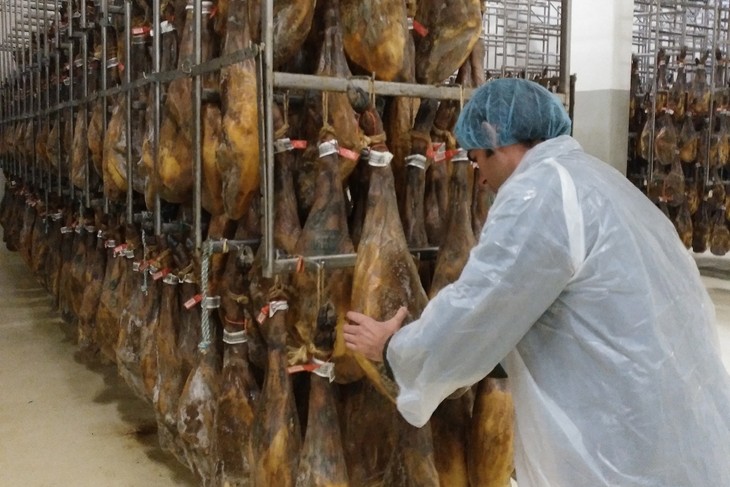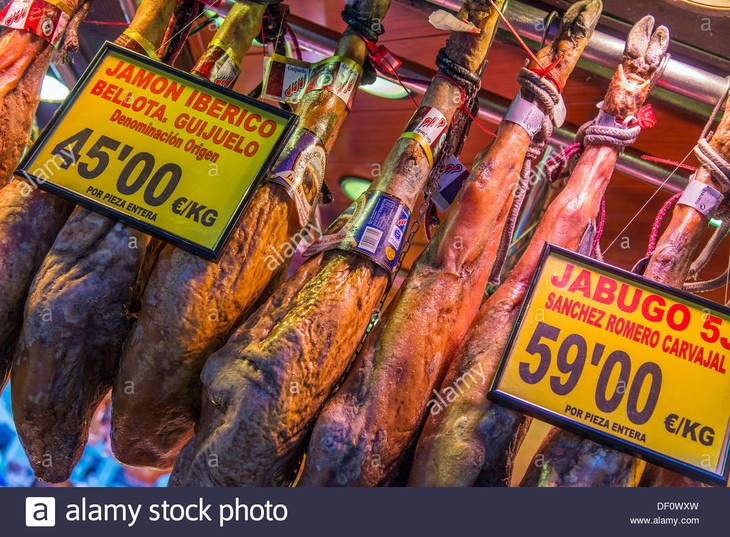(VOVWORLD) - It’s said that some foods are so amazing that after trying them once, you know you’re hooked for life. Iberian ham is one of those foods. Irene Reguilón, a native of Spain and a lecturer at Vietnam National University in Hanoi, will explain why we should be eating this heavenly treat!
 Iberian ham, one of the tastiest tapas in Spain! (Photo: blog.amigofoods.com) Iberian ham, one of the tastiest tapas in Spain! (Photo: blog.amigofoods.com) |
Bao Tram: Hello, Irene Reguilon. Welcome to VOV.
Irene: Thank you very much, Tram, for inviting me. I’m very happy to be here.
Bao Tram: I’ve heard that Iberian ham, or jamón Ibérico, is one of the most expensive cured meats in the world. Is it true that just a leg can cost as much as 4,500 USD? What is it about this cured meat that makes it so expensive?
There are many factors that lead to the high price of jamón ibérico. Some of these would be its process of elaboration, the time it takes for the product to go on to the market (which can be more than 36 months), the fact that it is an entirely artisanal product, the high quality of the product (made from 100% guaranteed pure bred Iberian pork), and limited production capacity, as that depends on the yearly acorn production.
Iberian pigs live freely in the meadow lands and they only eat acorns and natural products they find in the pasturelands. They can’t eat animal processed feeds. The outcome is a product 100% natural, without preservatives or artificial colours. The final product needs to come exclusively from 100% guaranteed pure bred Iberian pork. It can never be a cross breed. Also, its feeding needs to be fully natural, predominantly acorns, no animal feed can fit in its diet.
 Iberian pigs on the dehesa (Photo credit: Enrique Tomas) Iberian pigs on the dehesa (Photo credit: Enrique Tomas) |
Bao Tram: Which regions of Spain produce Iberian ham?
Irene: Iberian Cured Hams are protected under a Protected Declaration of Origin (called DOP after the Spanish initials). This is a recognized trademark assigned to agricultural and food products whose production phases are all localized in a specific geographic area, and whose production process complies with the well-defined production regulations and traditional recipes.
In Spain, there are four Ibérico Designations of Origin:
1. DOP GUIJUELO. Guijuelo is a municipality located in the province of Salamanca, in the Spanish Autonomous Community of Castilla y León, in the center of the Iberian Peninsula.
2. DOP DEHESAS DE EXTREMADURA. This DOP covers Cáceres y Badajoz, two provinces that form the Spanish Autonomous Community of Extremadura.
3. DOP JABUGO. This DOP refers to Huelva, a province of the Spanish Autonomous Community of Andalucía, the Southern region of the country.
4. DOP LOS PEDROCHES. This DOP refers to Córdoba, another province located in the Spanish Autonomous Community of Andalucía.
 Fuente la Virgen, a top producer of ham from acorn-fed pigs Fuente la Virgen, a top producer of ham from acorn-fed pigs (Photo: José Torrego/ startupsreal.com)
|
Bao Tram: How is Iberian ham processed?
Irene: After the pork is slaughtered when it has reached an optimum weight, it goes on to the quartering and cutting phase, which is performed by hand in the traditional way. The front legs (shoulders or “paletillas”) and the back legs (ham or “jamón”) are cut in a rounded shape. Then, we move on to the salting process, which consists of covering the pieces of ham and shoulders with sea salt for an approximate duration of one day per kilo. Halfway through, all pieces need to be turned over so that the salt is distributed evenly. The pieces are kept in chambers to keep a stable temperature, between 0 and 5 degrees, and also to maintain the humidity between 75% and 90%. Pieces are covered in salt; therefore, no preservatives or colorants are used in the process. This way, the pieces are dehydrated naturally causing the emergence of their raw aromas and colours.
Bao Tram: How long does it take to process a leg of Iberian ham?
Irene: The Iberian pig feeding takes 18 months until it is slaughtered. After that, the time of its curing or drying varies depending on factors such as the weight of the pig and the climate (which needs to be dry and cold. To get a leg of Iberian ham would take no less than 20 months up to 40 months or even more. For instance, a ham of less than 7 kg. would take from 22 to 24 months and a ham of more than 7 kg. could take from 40 months onwards.
Bao Tram: Well, it takes such a long time for processing. What are the key points in producing an Iberian ham?
Irene: The breed of the pig, which needs to be 100% guaranteed purebred Iberian pork, its entirely natural feeding, its free-range life, the timing of each step of its elaboration process (the cutting, the salting, and the curing or drying). Also, the moisture, ventilation, and temperature of the venue.
Bao Tram: How can one tell if a ham is good?
Irene: Its smell, color, and taste. When you buy a ham, you prick the base of the bone and depending on the smell you know whether is a good ham or not. When you cut it, you can tell if it is a good ham by its colour. But above all, its flavour and the fact that the slices melt in your mouth. Iberian ham must always be cut in “tapitas”, very thin slices.
 Spanish hams hang in La Boqueria market, Barcelona, Catalonia, Spain (Photo: Stefano Politi Markovina/Alamy Stock Photo) Spanish hams hang in La Boqueria market, Barcelona, Catalonia, Spain (Photo: Stefano Politi Markovina/Alamy Stock Photo) |
Bao Tram: How can one recognize an authentic Iberian ham?
Irene: We need to look at the label of the ham itself. If the label is black, it means that the pig had been fed 100% with acorns and is 100% purebred Iberian pork. We also have to check the label stating its DOP. But at first sight, we can also tell from the leg of the ham:
1. The shank or “caña” (which is the lean meat part of the hoof) is much thinner in the Iberian pork.
2. The shape of the leg of the Iberian pork is longer and more slender.
3. V-shaped cut. Iberian pork has a V-shaped cut right where the shank ends.
Another simple and traditional way to recognize a true Iberian ham would be to take notice of the fat of the ham and try to insert a finger into it. If the fat shines and you can stick your finger in it easily, it is Iberian ham. But if you can’t, the ham would be an ordinary ham or a mix-fed cured ham, not an Iberian ham.
Bao Tram: Thank you so much, Irene, for joining us today and sharing with us some facts about Spain’s Iberian ham.
Irene: Thank you again for inviting me. It’s a great pleasure.